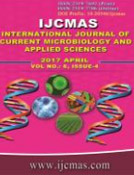


 National Academy of Agricultural Sciences (NAAS)
National Academy of Agricultural Sciences (NAAS)

|
PRINT ISSN : 2319-7692
Online ISSN : 2319-7706 Issues : 12 per year Publisher : Excellent Publishers Email : editorijcmas@gmail.com / submit@ijcmas.com Editor-in-chief: Dr.M.Prakash Index Copernicus ICV 2018: 95.39 NAAS RATING 2020: 5.38 |
A field experiment was carried out during the rabi season of 2011-12 and 2012-13 at Bihar Agricultural University, Sabour (Bihar) to assess the effect of integrated weed management practices on weed dynamics, productivity and nutrient uptake of maize (Zea mays L.). Results revealed that weed management practices had positive influence on growth, yield attributes, yields and nutrient uptake of maize. Significantly lower weed density, weed dry weight and weed control efficiency (WCE %) were recorded in zero tillage (ZT) compared with conventional tillage (CT). Among the chemical weed control practices, ZT-Glyphosate pre-plant followed by Atrazine + Halosulfuran (1.0 kg + 90 g a.i./ha) as post-em. and ZT-Glyphosate pre-plant followed by Topramezone +Atrazine @ (40 ml + 500 g a.i./ha) as post-em. proved equally effective in increasing the growth and yield attributes, yields, economic advantage and recorded higher N, P and K uptake by maize, 22.7 to 24, 37.2 to 38.6 and 20.6 to 20.8%, respectively compared with unweeded check. The maximum grain yield of (8.92 t/ha) was recorded under 2 HW at 15 and 30 DAS and performed statistically at par in grain yield obtained with ZT-Glyphosate pre-plant followed by Atrazine+Halosulfuran (1.0 kg+90 g a.i./ha) as post-em. (8.90 t/ha), CT-Acetochlor @ (3.0 lit. a.i./ha) as pre-em. (8.57 t/ha), ZT-Glyphosate pre-plant followed by Topramezone+Atrazine (40 ml + 500 g a.i. /ha) as post-em. (8.45 t/ha) and these grain yield was significantly superior to the rest of weed management practices. The highest net return Rs.55767/ha was noted in ZT-Glyphosate pre-plant followed by Atrazine+ Halosulfuran (1.0 kg + 90 g a.i./ha) as post-em. and the maximum B: C ratio of 1.98 was recorded under ZT-Glyphosate pre-plant followed by Maize+ Lathyrus as intercrop.
 |
 |
 |
 |
 |